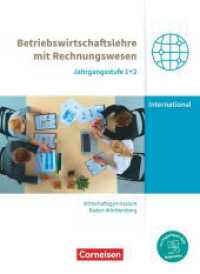- ホーム
- > 洋書
- > 英文書
- > Science / Mathematics
Full Description
Tight junctions between epithelial and endothelial cells form selective barriers and paracellular channels and regulate paracellular transport of solutes, immune cells, and drugs. More specifically, tight junctions consist of proteins that laterally interconnect neighboring cells of epithelia and endothelia. Certain proteins seal the tight junction, so that a nearly impermeable barrier develops, whereas others form channels that allow for permeation between the cells. Recent investigations have focused on tight junction proteins, belonging to the claudin family (claudins-1 to -27 in humans) and the newly defined group of TAMP (three proteins: occludin, Marvel-D2, and tricellulin). Barriers and Channels Formed by Tight Junction Proteins I showcases work in this area clustered around three major themes: the molecular properties of tight junctions, for example, the role of the claudin family of proteins and the formation of ion and charge-selective channels; the regulation of tight junction and barrier functions via genetic mechanisms and scaffold protein mediation; and the functional role of the tight junction in various tissues, such as the skin, lungs, endothelia, and nervous system
NOTE: Annals volumes are available for sale as individual books or as a journal. For informatio.n on institutional journal subscriptions, please visit http://ordering.onlinelibrary.wiley.com/subs.asp?ref=1749-6632&doi=10.111/(ISSN)1749-6632.
ACADEMY MEMBERS: Please contact the New York Academy of Sciences directly to place your order (www.nyas.org). Members of the New York Academy of Science receive full-text access to the Annals online and discounts on print volumes. Please visit http://www.nyas.org/MemberCenter/Join.aspx for more information about becoming a member.
Contents
1. Perspectives on tight junction research
Jörg-Dieter Schulzke, Dorothee Günzel, Lena J. John, and Michael Fromm
Molecular properties of the tight junction
20. Charge-selective claudin channel
Susanne M. Krug, Dorothee Günzel, Marcel P. Conrad, In-Fah M. Lee, Salah Amasheh, Michael Fromm, and Alan S. L. Yu
29. Claudin-derived peptides are internalized via specific endocytosis pathways
Denise Zwanziger, Christian Staat, Anuska V. Andjelkovic, and Ingolf E. Blasig
38. A phosphorylation hotspot within the occluding C-terminal domain
Max J. Dörfel and Otmar Huber
45. Determinants contributing to claudin ion channel formation
Anna Veshnyakova, Susanne M. Krug, Sebastian L. Mueller, Jörg Piontek, Jonas Protze, Michael Fromm, and Gerd Krause
54. Lipolysis-stimulted lipoprotein receptor: a novel membrane protein of tricellular tight junctions
Mikio Furuse, Yukako Oda, Tomohito-Higashi, Noriko Iwamoto, and Sayuri Masuda
59. Overexpression of claudin-5 but not claudin-3 induces formation of trans-interaction-dependent multilamellar bodies
Jan Rossa, Dorothea Lorenz, Martina Ringling, Anna Veshnyakova, and Joerg Piontek
67. Association between segments of zonula occludens proteins: live-cell FRET and mass spectrometric analysis
Christine Rueckert, Victor Castro, Corinna Gagell, Sebastian Dabrowski, Michael Schümann, Eberhard Krause, Ingolf E. Blasig, and Reiner F. Haseloff
77. Dynamic properties of the tight junction barrier
Christopher R. Weber
Regulation of the tight junction and barrier function
85. Regulation of tight junctions in human normal pancreatic duct epithelial cells and cancer cells
Takashi Kojima and Norimasa Sawada
93. The role for protein tyrosine phosphatase nonreceptor type 2 in regulating autophagosome formation
Michael Scharl and Gerhard Rogler
103. Caveolin binds independently to claudin-2 and occluding
Christina M. Van Itallie and James M. Anderson
108. Regulation of epithelial barrier function by the inflammatory bowel disease candidate gene, PTPN2
Declan F. McCole
115. Intracellular mediators of JAM-A-dependent epithelial barrier function
Ana C. Monteiro and Charles A. Parkos
125. Cingulin, paracingulin, and PLEKHA7: signaling and cytoskeletal adaptors at the apical junctional complex
Sandra Citi, Pamela Pulimeno, and Serge Paschoud
133. ZO-2, a tight junction scaffold protein involved in the regulation of cell proliferation and apoptosis
Lorenza Gonzalez-Mariscal, Pablo Bautista, Susana Lechuga, and Miguel Quiros
142. From TER to trans- and paracellular resistance: lessons from impedance spectroscopy
Dorothee Günzel, Silke S. Zakrzewski, Thomas Schmid, Maria Pangalos, John Wiedenhoeft, Corinna Blasse, Christopher Ozboda, and Susanne M. Krug
Tight junctions in skin, lung, endothelia, and nervous tissues
152. Diverse type of junctions containing tight junction proteins in stratified mammalian epithelia
Werner W. Franke and Ulrich-Frank Pape
158. Barriers and more: functions of tight junction proteins in the skin
Nina Kirschner and Johanna M. Brandner
167. Roles for claudins in alveolar epithelial barrier function
Christian E. Overgaard, Leslie A. Mitchell, and Michael Koval
175. Claudins and alveolar epithelial barrier function in the lung
James A. Frank
184. Relevance of endothelial junctions in leukocyte extravasation and vascular permeability
Dietmar Vestweber
193. Involvement of claudins in zebrafish brain ventricle morphogenesis
Jingjing Zhang, Martin Liss, Hartwig Wolburg, Ingolf E. Blasig, and Salim Abdelilah-Seyfried
199. Modulation of tight junction proteins in the perineurium for regional pain control
D. Hackel, A. Brack, M. Fromm, and K. L. Rittner








